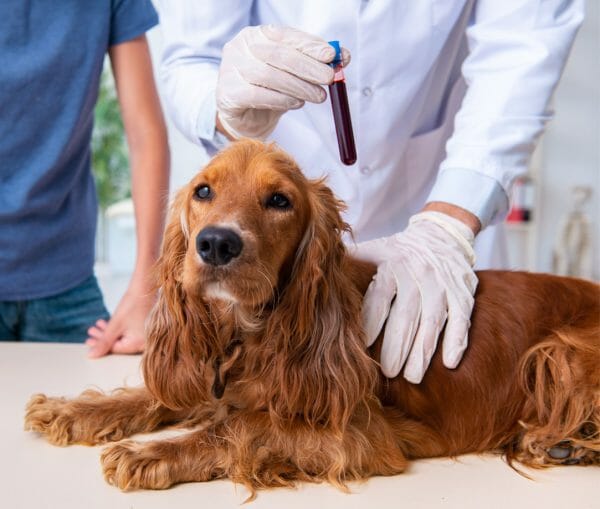What is Cushing’s Disease in Dogs?
Cushing’s disease in dogs affects the endocrine system, which is one of the most important parts of the body in both humans and animals. Within this glandular system, various facets of the body are constantly being adjusted according to the particular messages the body is sending. The hormones that are regulated and produced in the endocrine system control much of the body’s functioning, much more than most people realize.
For this reason, Cushing’s disease in dogs can be a devastating illness for a dog to acquire. Cushing’s disease involves the overproduction of the hormone cortisol within the endocrine system of the body. Although this may sound harmless, it is far from it.
A surplus of cortisol within the body can cause some or many of the problems listed below:
- Spikes in blood sugar
- Spikes in blood pressure
- Recurring infections
- Thinning skin and hair
- Abnormal increases in hunger or thirst
Normal levels of cortisol are needed to regulate these things and keep them in balance. When there is an underproduction or overproduction of cortisol (as is the case with Cushing’s disease), it can create an unhealthy situation. For dogs with preexisting health conditions, the conditions associated with too much cortisol can be even more detrimental to the dog’s health.
Cushing’s disease is mostly seen in dogs that are 8 years of age or older. Interestingly, some dog breeds receive the diagnosis of Cushing’s disease more than others. Dog breeds prone to Cushing’s disease include Boxers, Beagles, Dachshunds, Golden Retrievers, and Labrador Retrievers. In spite of this, any breed of dog can be diagnosed with this illness.

Symptoms of Cushing’s Disease in Dogs
The symptoms associated with canine Cushing’s disease are easily recognizable in most cases once they come to fruition. When the dog internally develops the problem, an entire year can go by before any symptoms begin to show up. This means that early stage Cushing disease in dogs may be easily overlooked. When the signs of Cushing’s disease eventually exhibit themselves, they can be mistaken for a routine illness or signs of seniority.

Given this information, it can be complicated to determine if your dog has Cushing’s disease or it is simply in the process of aging. The following symptoms should be taken seriously if your dog is older or a member of one of the breeds more prone to contracting the illness:
- Unusually high intake of water or food
- Recurrent need to urinate, often resulting in accidents
- Overextended stomach
- Uncharacteristic decrease in activity
- Sluggish and slow movements
- Difficulty breathing
- Infections
One of the surefire symptoms that represents the illness is excessive drinking of water and subsequent urination. Your dog may also look physically older with all of these conditions affecting it. When it comes to Cushing disease dog behaviors, your dog may not act as they normally do, which should also be noted.
Making a Diagnosis
The symptoms of Cushing’s disease and treatment can be hard to accurately discern not only for the reason that they resemble natural aging, but because the techniques used to assess and diagnose the condition are expensive and imprecise.
Diagnostic tools that render complete accuracy have not been produced yet. Because of this, vets must use several different forms of testing to ascertain whether Cushing’s disease is present or not. Some of the diagnostic tests that vets tend to use are:
- Tests of urine, cortisol, and the thyroid gland
- Blood tests
- Low-dose dexamethasone suppression test (LDDST)
- High-dose dexamethasone suppression test (used to diagnose which form of Cushing’s is present in a canine)
Numerous other tests are available and may also be used in diagnosing your pet. The selection of particular tests is left up to the discretion of your veterinarian.

What Causes Cushing’s Disease in Dogs?
The overproduction of the hormone cortisol in Cushing’s disease is often attributed to the presence of a tumor, either in the pituitary gland or the adrenal gland of the endocrine system. The symptoms of Cushing’s disease and treatment that is decided upon is particular to the specific type of the illness that is present. There are three types of Cushing’s disease.
The first type is pituitary-dependent. In this type, a tumor is usually located at the posterior region of the brain in the pituitary gland. This type makes up almost 85% of cases of Cushing’s disease. The tumor is benign in most situations. When the adrenocorticotrophic hormone (ACTH) is not being properly regulated by the pituitary gland, excess of cortisol is the result.
The second type is adrenal-dependent. This occurs when a tumor is found on the adrenal glands of the endocrine system. The presence of the tumor impedes the normal regulation of cortisol. Found in 15% of cases of Cushing’s disease, this type of tumor can be benign or malignant. If it is malignant, it becomes an adenocarcinoma.
A third, more infrequent form of Cushing’s disease in dogs is what is known at iatrogenic. In this case, an overuse of steroids or steroidal medications are the cause. Luckily, if this form of the illness is detected, simply suspending the use of steroids should control and end the illness without further issues.

How Long Does a Dog Live with Cushing’s Disease?
The lifespan of a dog with Cushing’s disease is contingent on many factors. However, depending on the severity of the illness, a dog may live up to 2 to 4 years after being diagnosed. The chances that a dog with severe Cushing’s lives past the 4-year mark is unlikely and has been found to occur in only about 10% of cases.
In cases where the illness is caught early, dog treatment for Cushing’s is accessible. In most cases of pituitary-dependent tumors, oral medications such as Lysodren or Vetoryl can be taken to combat the tumor. Surgery is rarely required.
On the other hand, if an adrenal-dependent tumor is detected, this presents a more delicate situation. These types of tumors are often large in size and are malignant 50% of the time. Tumors of this nature must be surgically removed, which may bring about further issues. One problem is that surgeries of this kind are currently in the early stages of development.
In whatever case, symptoms of Cushing’s disease and treatment should be assessed and determined by the professional opinion of a board-certified veterinarian.



